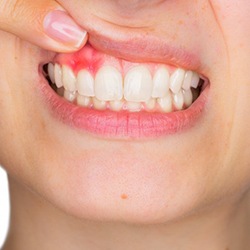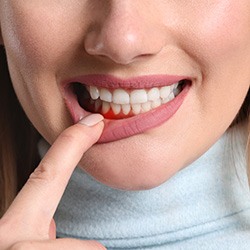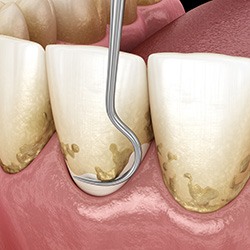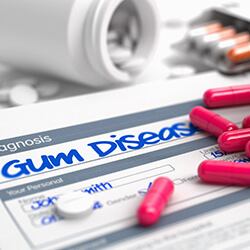Periodontal Treatment – McKinney, TX
Renewing Healthy Smiles After Gum Disease
Periodontal disease (also known as gum disease) is a common health problem that affects a majority of the US population, and untreated cases can eventually result in serious consequences. In fact, gum disease is the leading cause of tooth loss in adults in the US! That’s why the OakBrook Dental & Orthodontics team takes treating gum disease so seriously. We strongly recommend attending regular periodontal screenings so that our doctors can discover tell-tale signs of an infection at their earliest, most harmless stages. If needed, we offer several forms of periodontal treatment to help renew your healthy smiles after gum disease. Contact our McKinney location today to get started!
Why Choose OakBrook Dental & Orthodontics for Gum Disease Treatment?
- Gum Disease Screening During Every Dental Checkup
- Team of Highly Experienced Dentists Focused On Your Comfort
- We Accept All PPO Dental Insurance Plans & Medicaid
What is Gum Disease?

It’s common knowledge that you need to brush your teeth regularly to prevent cavities. But did you know that the bacteria that causes tooth decay is a threat to more than just your teeth? If plaque and tartar accumulate on your pearly whites, the bacteria they contain can begin to irritate your gums and even infect them. This is known as gum disease. The initial stage of gum disease is called gingivitis, which can be treated and even reversed if caught early enough.
However, if gingivitis is left untreated and the infection is allowed to get worse, it will progress into periodontitis. This advanced stage of gum disease has much more serious complications, including tooth loss and an increased risk of systemic health issues. Fortunately, periodontitis can be managed and controlled with the proper treatments.
Symptoms of Gum Disease

Periodontal disease can cause a wide variety of symptoms that will change depending on the individual and how far the issue has progressed. In general, there are several key symptoms that can indicate different stages of gum disease.
Signs of gingivitis include:
- Chronic bad breath that doesn’t go away even with good oral hygiene
- Gums that look puffy or bright red
- Gums that bleed easily when flossing or brushing
- Sensitivity or tenderness in the gum tissue
- Gum recession, which may cause your teeth to look longer than usual
Meanwhile, these symptoms will often indicate periodontitis:
- Severe tooth sensitivity
- Pain while chewing or eating
- Feeling like your bite has changed
- Restorations like crowns or partial dentures becoming loose
- Permanent teeth that feel loose or fall out
How Do We Treat Gum Disease?

While gum disease can have serious impacts on your oral health and overall well-being, it can be treated. At OakBrook Dental & Orthodontics, our team of highly experienced and trained dentists check for signs of gum disease during every dental checkup. Should you need periodontal treatment, we will recommend scaling and root planing or antibiotic therapy to get your smile back on track.
Scaling & Root Planing

For mild to moderate gum disease, our team advises scaling and root planing. This procedure is a “deep cleaning” of your gums that gets rid of their harmful oral bacteria. While the scaling uses various tools to remove plaque and tartar from around the gumline, root planing smooths out your tooth roots to ensure your gums reattach properly. The result is a non-surgical procedure that can make your gum tissues much healthier. To learn, keep reading or call us for details.
Do I Need Scaling & Root Planing?

Our dentists can assess your smile to see if you truly need scaling and root planing. That said, you should also consider whether you show symptoms that treatment would ease. Such signs include:
- A visible buildup of plaque
- Gum swelling or puffiness
- Sensitive or bleeding gums
- Receding gum tissue
- Persistent bad breath (i.e., halitosis)
These symptoms are often reversible with good oral care. Still, you’ll need scaling and root planing if your infection is severe. Only treatment would manage your symptoms at that point.
The Process of Scaling & Root Planing

Traditional scaling and root planing usually takes two dental visits. The first visit handles the initial scaling, while the second appointment performs the root planing.
The scaling visit is when most of the gum cleaning actually occurs. For this treatment phase, we use dental tools to remove plaque and tartar from above and below the gumline. The removal work even moves as far down as your gum pockets to ensure the best results.
Our team wraps things up at the later root planing appointment. During that session, our dentists smooth out your tooth roots and eliminate bacterial deposits stuck to them. These measures ensure your gum tissue will reattach healthily and reduce your risk of a re-infection.
Aftercare Tips for Scaling & Root Planing

As an invasive procedure, scaling and root planing involve weeks of recovery. That healing period can also include various aches and pains in your mouth. To manage such soreness, please use the following tips:
- Rest & Relax – Right after treatment, you’ll need to refrain from intense physical movement. You’d overwork your body otherwise and delay your healing progress.
- Eat Carefully – You should only eat soft foods for the first few days after treatment. At the same time, you’d also do well to avoid alcohol, acidic drinks, and anything spicy for a while.
- Brush Gently – To prevent gum irritation, gently brush your teeth with a soft-bristled toothbrush. Sticking with slow and circular motions will help you avoid aching gums.
- Do Salt Water Rinses – It’s a good idea to do salt water rinses for a few days post-treatment. By swishing with salt water, you’d reduce your gums’ irritation and loosen any lingering debris.
Antibiotic Treatment

ARESTIN antibiotic therapy is another important component of this treatment, and we often use it in combination with scaling and root planing. This medication is applied directly to the gum pockets so that it can target and destroy any remaining bacteria. As a result, patients are able to enjoy a smile that’s stronger and healthier!

